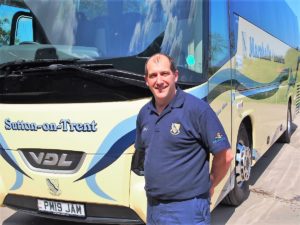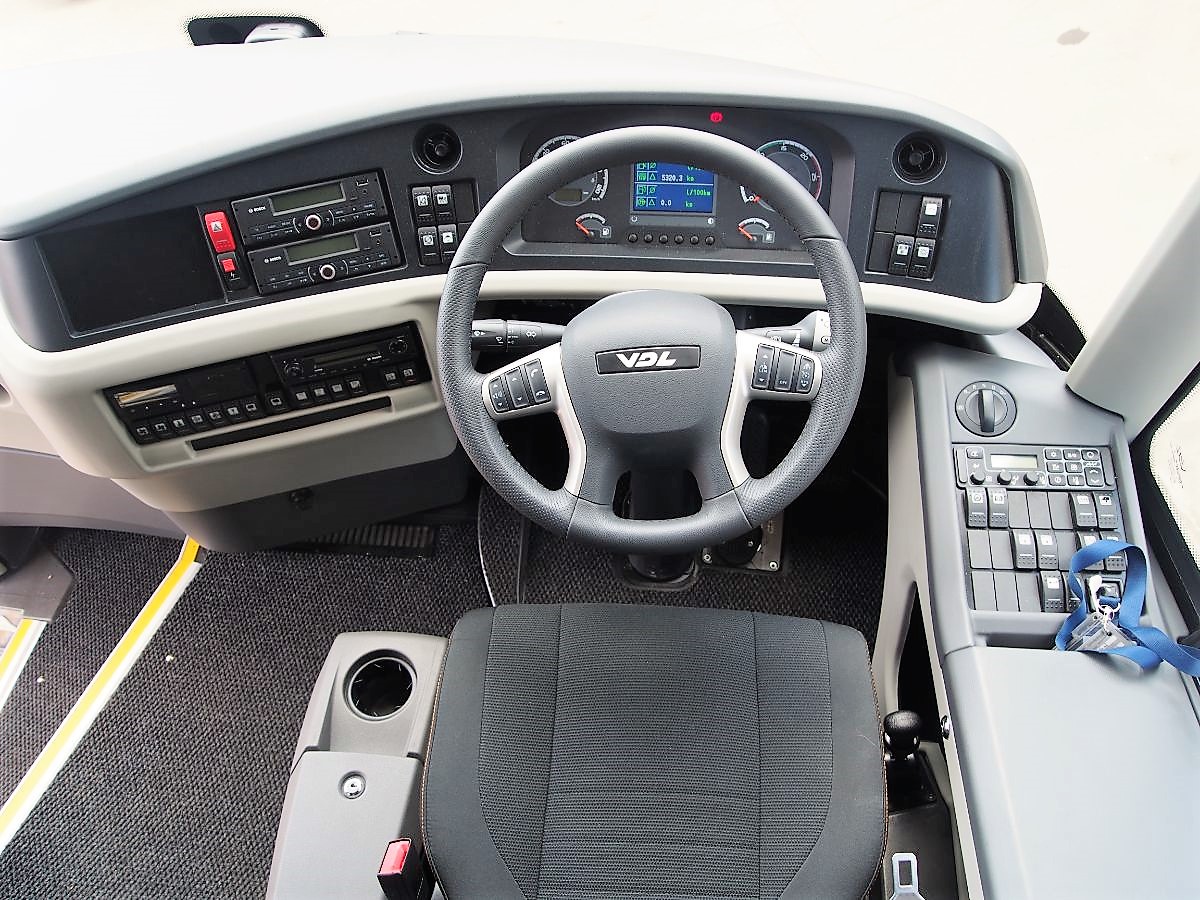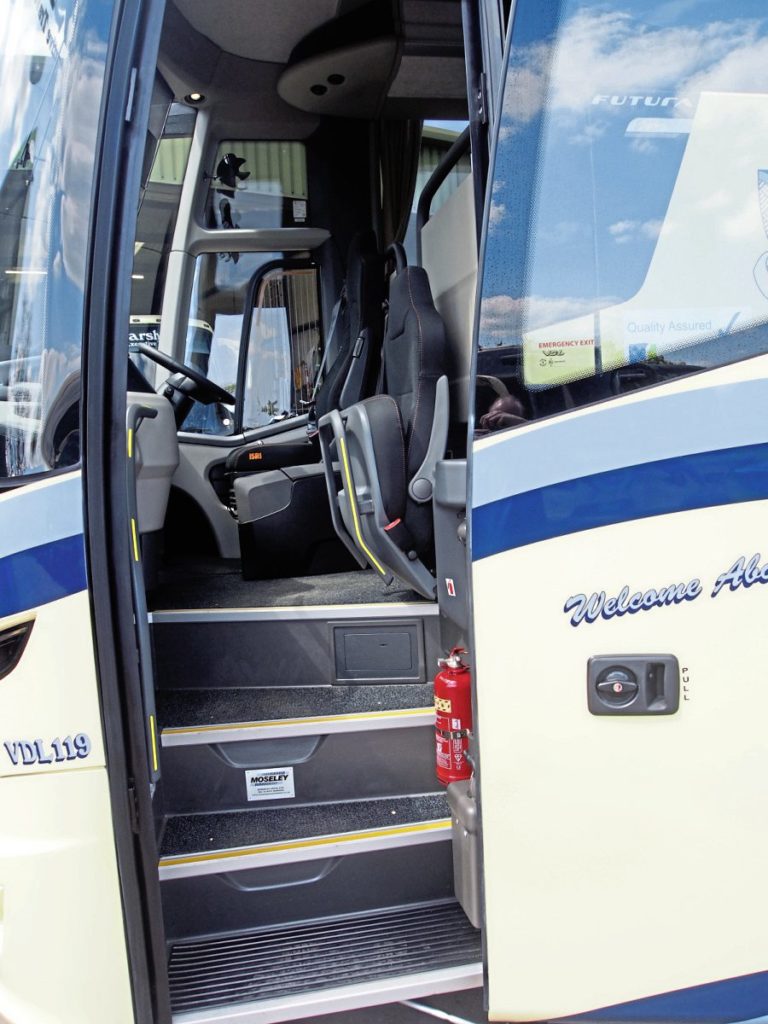Same quality, smaller coach
Something special was called for Marshalls of Sutton-on-Trent’s 30th year in business. The anniversary came just at the time the operator was seeking a small coach. So to mark the occasion, the company went for a brand new 10.8m VDL Futura FHD2. What also makes this new vehicle noteworthy is it is the first coach of its type in the UK to feature the ZF TraXon transmission.
Marshalls Director, Paul Marshall, is already a fan of Futuras, having three in his fleet prior to buying this latest one. One of the reasons behind this preference is the dealer, Moseley PCV. He said: “We have a good working relationship with Moseley. Their service, for us, is second to none. They took me to the factory and I was impressed with what I saw out there. I took the decision to order one while I was out there.”
Buying new vehicles is no frivolity for Paul and the rest of the Marshalls. “Because we are a family business, we don’t just throw money away. At the moment, we have been averaging probably every year to two years for getting new. In 2017, we had four new, then 2018 we didn’t have any. You have to be realistic, there are lots of changes going on, so we asked ourselves do we need to buy new vehicles?”
Having only recently entered the operator’s fleet, the new Futura has already gone down well and found a niche of work. Paul said: “We find there is a bit more market for this vehicle. There isn’t anyone in the area with anything quite like this. This month, it’s been out quite a lot.”
Paul mentioned he has been doing a lot of marketing to promote the fact he has it available for hire. Since it entered the fleet in April, it has already covered 5,000km.
Exterior
Externally, there is not a great deal different with the 10.8m version of the Futura FHD2 than its larger counterparts.
The distinctive bodywork of the Futura is one that can divide opinions. Admittedly, the lobed front is a design feature not to some operator’s tastes. Some say it is reminiscent of passenger aircraft, others that the previous model resembled their own pot belly! But whatever your opinion, you have to admit it is at least recognisable to both operators and passengers. The front on the latest version of the marque may not be as pronounced now as it was in older versions, having slimmed down considerably, but it is still a trademark feature that’s present.
“It’s not the prettiest vehicle and it never will be,” Paul admitted. “But if you want the vehicle to do the job, this is it.”
Attracting Paul to it was the customer service at Moseley. “They’re very customer service focused.”
Paul opened up the engine compartment and the side access point. With his engineering hat on, he commended the amount of room there is around the engine bay for working on it.
Interior
Stepping on board, it is not immediately apparent this is a shorter version of the Futura. It has the bearing of a more standard size touring coach.
Impressed with the vehicle, Paul was very pleased with the colour of the moquette he has had fitted on the Brusa seats. “It’s perfect for our livery. We had the headrests changed to a more serviceable colour.”
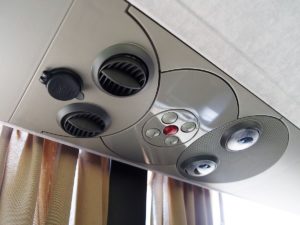
Well appointed passenger service units are fitted, but it’s hoped passengers have long enough cables to use the USB sockets placed above head
Seating capacity has been reduced to make way for two tables near the front of the coach. Paul said: “There is nothing else in this area this size with tables; it seems to be attracting quite a bit of business. If you’ve got a group of 25 or 30 on a trip, if you turn up with this they feel wanted. A bigger coach for that size group makes it seem empty. It doesn’t look good. This gives that full-size coach feel for something shorter.”
The moquette is blue and is accented with a lighter blue and white leather trim. The carpet is a complementary blue, while the ceiling and luggage rack lining is a light grey. The choice of colour for the latter, as well as the beige curtains, help what could be a drab interior due to the dark moquette appear light and airy, lifting up the internal appearance. Even when parked in shade, it did not feel gloomy as some smaller coaches do.
Moving down the aisle, the coach has a servery above the toilet. The toilet itself was as you would expect in a coach, not the most spacious of areas, but completely serviceable and one passengers would be happy to use if caught between service stations.
Hand luggage racks appeared to give enough room for handbags and rucksacks. On close inspection they felt sturdy.
Above each pair of seats were passenger service units with reading lights, service button and air conditioning controls. USB sockets were provided on these too, as they are for increasingly more coaches. However, one criticism is they are above head, meaning wires must trail down from the ceiling if they are used for charging. This may cause problems with wires that are not long enough, with nowhere for the phone or tablet to be put down. There are some sockets by the table, which are more accessible.
The Futura’s luggage capacity is said to be good for its size. Paul compared it to that of other similar sized coaches, which he says just do not have the luggage space.
There is plenty of room for the driver too. The dashboard is ergonomically designed, with switches not commonly needed lower down. The layout is familiar to anyone that has driven many other Futuras. Paul is pleased to see the omission of the pull-out cup holders other VDLs feature in the driving area. These, he said, would often break, as they are easily caught accidently by a driver’s leg when moving around.
Driving position is good, according to Paul, with no obstruction of vision reported. An Isri driver’s seat is installed, which Paul was fond of, giving plenty of support. He liked the fact it has various adjustments and is mechanically very simple. It is heated and has lumber support, Bluetooth connectivity and a microphone.
A minor criticism was from a driver from Marshalls fleet. He found cleaning the inside of the windscreen difficult due to the poles fixing the blind in place being attached to the glass.
The interior layout impressed judges at the UK Coach Rally this year, where it won the Boon Award for best coordinated décor.
Driving
Paul was very positive about the coach, but to prove his words, we took it out on the roads. The route we took stemmed from the pleasant village of Sutton-on-Trent and then on to the A1, five minutes from the depot. After driving north on the motorway, we turned off after the village of Elkesley, journeying through the Nottinghamshire countryside, taking in the historic village of Laxton where the medieval open field system is still observed. The route looped us back around to Sutton-on-Trent. This gave a varied driving experience, taking in motorway driving, as well as A roads and narrow, twisting rural byways. It was a warm, dry, sunny day, which is ideal for driving, but perhaps doesn’t push the vehicle to reasonable limits.
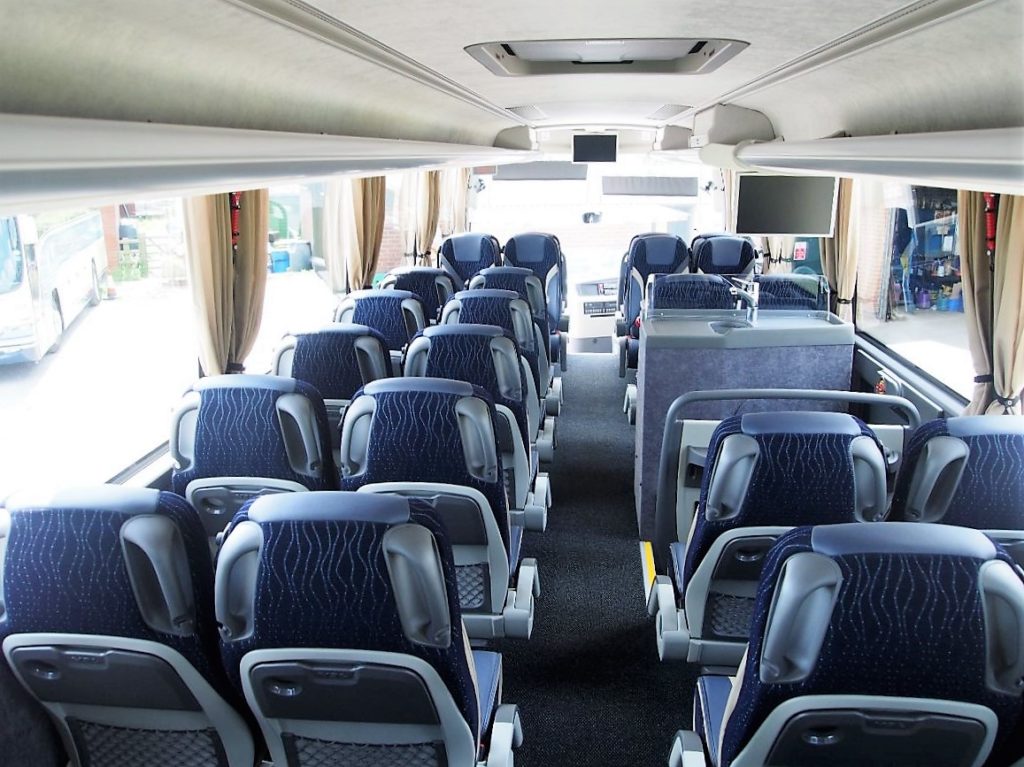 Pulling out from the depot, one thing to take note of was the performance of the ZF TraXon transmission. This is perhaps what really makes this vehicle stand out. Paul is certainly a fan of this gearbox, saying it is considerably better than the ZF AS-Tronic other Futuras are fitted with. He never considered the AS-Tronic as being in the same league as some other transmissions, notably Volvo’s iShift. He said: “But this TraXon is in the league of the iShift.”
Pulling out from the depot, one thing to take note of was the performance of the ZF TraXon transmission. This is perhaps what really makes this vehicle stand out. Paul is certainly a fan of this gearbox, saying it is considerably better than the ZF AS-Tronic other Futuras are fitted with. He never considered the AS-Tronic as being in the same league as some other transmissions, notably Volvo’s iShift. He said: “But this TraXon is in the league of the iShift.”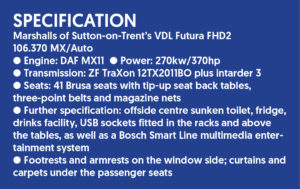
He was complimentary of the Futura’s transmission’s manoeuvre mode, which he said eases control of the vehicle when it’s going slower, aiding reversing.
At the next junction, it glided away from a standstill. He said: “There’s no jerking. It pulls away like a manual gearbox.”
Heading out onto the A1, Paul said of the gearbox’s performance: “It knows its limits, knows what it needs.”
During the village roads, there was very little, if any, rattle. Setting out onto the motorway, it was notable how little noise there was coming from the interior. The only sound from the internal fittings was a very slight rattle and squeak that seemed to be coming from the screen above the servery.
Engine noise was low. A conversation could be had easily between the driver and two seats back without voices having to be raised. Paul said: “It’s that DAF engine, the MX11; it’s always very quiet.”
Speaking as a passenger on the road test, I found the ride smooth and enjoyable. Paul noted: “A major thing is the fact it’s on full-size wheels.” Coaches of a similar size to this Futura can often be equipped with smaller wheels.
Testing the passenger experience from the front, middle and back of the coach, it may be rather surprising from a rear-engine vehicle that it was quietest at the rear. It was a fairly warm day for May and the air conditioning system was doing its job well, providing a moderate temperature throughout the vehicle without making too much noise.
The Futura had some healthy acceleration, getting to 62mph quickly when on the motorway. It pulled up hills with ease. “The DAF MX11 engine gives a lot of power for what you’re carrying,” Paul noted. “VDL seem to be getting it right. We like the DAF engine.”
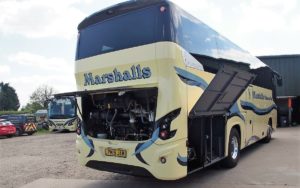 The Futura’s Adaptive Cruise Control kicked in while on the motorway, ensuring the coach stays within three cars length of vehicles in front. Paul demonstrated it by pulling in behind a truck in the left-hand lane, which automatically made the coach slow to 56mph, positioning it a safe distance from the truck.
The Futura’s Adaptive Cruise Control kicked in while on the motorway, ensuring the coach stays within three cars length of vehicles in front. Paul demonstrated it by pulling in behind a truck in the left-hand lane, which automatically made the coach slow to 56mph, positioning it a safe distance from the truck.
An issue he demonstrated with the Adaptive Cruise Control is when trying to overtake. As it needs to see the road ahead is clear before it accelerates, this means it can be slow to pull away once it moves into the right-hand lane of a motorway, due to vehicles being close ahead. This, Paul said, could annoy drivers behind the coach. Paul said: “There’s nothing you can do about it. It’s the way it is.” The system can be overridden, avoiding the delay in acceleration.
We turned off the A1 towards Clumber Park. As Paul did this, he slowed smoothly only using the retarder, all but for the last few metres. Wending its way around the tight roads of the Nottinghamshire countryside, it handled well.
Paul said: “It feels solid; it’s responsive. You don’t feel like you’re fighting it at all. It doesn’t roll, there is no wallow. You can sit in it all day and drive.”
From a passenger’s point of view, Paul’s words were accurate. It was a smooth ride. The seats, although not small by any stretch of the imagination, were snug. Although it can be imagined that someone considerably bigger would perhaps find them a little restrictive in space, the same could be said for all seats.
Back at Marshall’s depot, one of drivers, Howard Wesley, talked about the new Futura. He recently drove it to the Lake District and said of it: “I tried the manual selection on the gearbox and it worked all right, there were no issues. There is no hunting for gears. The Cruise Control was good too. It’s a good machine. And passengers said it was a comfortable ride.”
Paul is happy with the fuel economy it is achieving. He accomplished 15mpg when he picked it up from Moseley PCV in Pontefract, a journey of around 40 miles via motorway and main roads. He said it does not cost much less to operate than a larger Futura, but he is getting better fuel economy. Howard said he made it up to the Lake District and back to the depot on half a tank of fuel.
One issue Howard flagged with it was that when it is foggy, the camera for the lane assist camera cannot pick up where the vehicle is and displays a warning light to the driver despite being safely on the road. Sunshine glaring into the camera had a similar affect. In our test drive, the lane departure was working well, vibrating the seat when the vehicle touched the white lines. However, Paul did turn it off on some of the more rural roads, as they were too narrow for it to work properly.
Howard gave a positive report of its performance behind the wheel: “It’s good. The Cruise Control doesn’t murmur.”
Something the drivers were mildly concerned about was the overhang. They reported a strong enough wind can catch it at the rear and even knock it out of cruise control. Howard said: “With that overhang, you have to be careful with it.”
Paul is confident the residual value of the coach will be favourable. He said: “In ten years’ time, I think the value of the vehicle will be more than something built in China or Turkey.”
Verdict
For Paul, it is not just the coach itself, but the back up and service he receives from Moseley that wooed him to buy it. He is definitely impressed, but then he would be; he is already a fan of the Futura, having taken three previously.
Particular attention was paid to the TraXon transmission and it was found to perform well. The gear changes were perceptible only when looking out for them, they were sufficiently smooth. There was no hunting of gears perceived, it seemed to find the correct one succinctly on all occasions during the test drive and there was no jerking from it. The engine provides plentiful acceleration. As a passenger, to sit in the comfortable seats and drift along the country roads by the rapeseed fields was a most pleasurable experience. It was a relaxing ride.
There seems to be a growing market for this size coach, as Paul is finding. Although more expensive than some vehicles of this size, the extra quality you are paying for with the VDL Futura FHD2 makes it stand out. As the years go by, it will be interesting to see how much residual value it retains compared to others in this size category.
Model history
Back to the Futura
The Futura range first came onto the market in 1982, brought into being by its original manufacturer, Bova. It was the successor of the Europa model. Unlike its predecessor’s angular bodywork designs, the Futura is known for its curved shapes and prominent bulge at the front.
DAF engines were fitted as standard from the very beginning. Although in the past, Mercedes-Benz, Cummins and MAN options were also available prior to Euro III standards coming in. When this emission grade was introduced to the range, only DAF was offered.
They were introduced as 12m long coaches, but in 1990 the range saw a 10.4m variant added. A third length came in 1996, the 12.7m long FH13/FL13. The Futura Magnum, a tri-axle version, was added in 1993.
Various changes have been made to the range over the years, including the addition of large circular headlamps in 1982. In 1988, smaller rectangular headlamps were repositioned slightly higher up the front of the coach. A further revision to the headlamps came in 1999 and another one in 2007, when the lobed front was slimmed down.
The biggest change came in 2010, when the Bova name was dropped and the bulbous front was considerably shrunken for a more upright front. It won the International Coach of the Year title in 2012.
The range was extended in 2015 to include the VDL Futura FDD2, a double-deck coach to replace the VDL Synergy.
